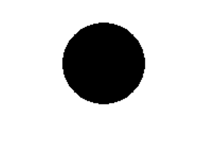霍夫梯度:检测的圆与原始影像具有相同的大小
检测到的相邻圆的中心的最小距离(如果自变量太小,除了一个真实的圆外,还可能会错误地检测到多个相邻圆,如果太大,可能会漏掉一些圆,)
在#HOUGH梯度的情况下,它是较高的. 两个阈值传递到Canny边缘检测器(较低的一个小两倍),
在#HOUGH梯度的情况下,它是检测阶段圆心的累加器阈值,它越小,就越可能检测到假圆;minRadius:最小圆半径maxRadius:最大圆半径,如果<=0,则使用最大影像尺寸,如果<0,则回传没有找到半径的中心,
PS:在opencv中经常使用cv2.findContours()函式来查找检测物体的轮廓

"""
-*- coding: utf-8 -*-
author: Hao Hu
@date 2021/12/3 8:00 AM
"""
import math
import cv2
import numpy as np
import matplotlib.pyplot as plt
def circular_detect():
"""霍夫变换圆检测"""
import cv2
# 载入并显示图片
img = cv2.imread('./circular.png')
# 灰度化
gray = cv2.cvtColor(img, cv2.COLOR_BGR2GRAY)
# 输出影像大小,方便根据影像大小调节minRadius和maxRadius
print(img.shape)
ret, thresh1 = cv2.threshold(gray, 200, 255, cv2.THRESH_BINARY)
cv2.imshow('thresh1', thresh1)
canny = cv2.Canny(thresh1, 40, 80)
cv2.imshow('Canny', canny)
canny = cv2.blur(canny, (3, 3))
cv2.imshow('blur', canny)
# 霍夫变换圆检测
circles = cv2.HoughCircles(canny, cv2.HOUGH_GRADIENT, 1, 100, param1=50, param2=30, minRadius=30, maxRadius=150)
# 输出回传值,方便查看型别
print('定义了一个三维阵列(x,y,r)',circles)
# 输出检测到圆的个数
print(len(circles[0]))
# 根据检测到圆的信息,画出每一个圆
for circle in circles[0]:
if (circle[2] >= 100):
continue
# 圆的基本信息
print('半径为',circle[2])
# 坐标行列
x = int(circle[0])
y = int(circle[1])
# 半径
r = int(circle[2])
# 在原图用指定颜色标记出圆的位置
img = cv2.circle(img, (x, y), r, (0, 0, 255), -1)
# 显示新影像
cv2.imshow('circular_detection', img)
def Ellipse_feature_extraction2():
img = cv2.imread("ellipse.png", 3)
imgray = cv2.Canny(img, 600, 100, 3) # Canny边缘检测,自变量可更改
ret, thresh = cv2.threshold(imgray, 127, 255, cv2.THRESH_BINARY)
contours, hierarchy = cv2.findContours(thresh, cv2.RETR_TREE, cv2.CHAIN_APPROX_SIMPLE) # contours为轮廓集,可以计算轮廓的长度、面积等
for cnt in contours:
if len(cnt) > 50:
S1 = cv2.contourArea(cnt)
ell = cv2.fitEllipse(cnt)
S2 = math.pi * ell[1][0] * ell[1][1]
if (S1 / S2) > 0.2: # 面积比例,可以更改,根据资料集,,,
img = cv2.ellipse(img, ell, (0, 255, 0), 2)
#print(str(S1) + " " + str(S2) + " " + str(ell[0][0]) + " " + str(ell[0][1]))
print(contours[0][0][0],contours[-1][-1][-1])
# 这是椭圆相隔最远的点
x = (contours[0][0][0][0] + contours[-1][-1][-1][0])/2
y = (contours[0][0][0][1] + contours[-1][-1][-1][1])/2
print('椭圆圆心',x,y)
r = math.sqrt((x-contours[0][0][0][0])*(x-contours[0][0][0][0])+(y-contours[0][0][0][1])*(y-contours[0][0][0][1]))
print('椭圆半径',r)
cv2.imshow("0", img)
if __name__ == "__main__":
# line_detect_possible_demo()
# circular_detect()
Ellipse_feature_extraction2()
cv2.waitKey(0)
cv2.destroyAllWindows()







0 评论